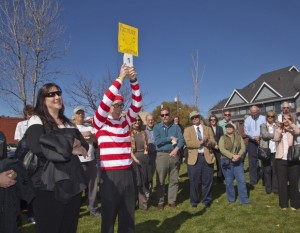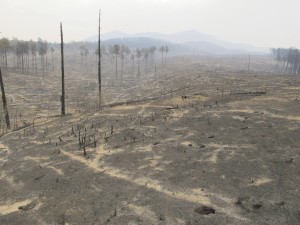AZ Daily Sun • JOE FERGUSON SUN STAFF REPORTER

Flagstaff City Manager Kevin Burke makes a bid for Picture Canyon Tuesday during the auction on the steps of the Coconino County Courthouse. The city bought 480 acres at Picture Canyon for $4.8 million from the State Land Department. (Courtesy photo by Tom Bean)
Donald Weaver saw past the rusting hulks of steel, rotting rubber and scattered piles of trash when he first began surveying Picture Canyon in the late 1970s.
An expert on the ancient petroglyphs painted on the canyon walls, Weaver vowed to protect from encroachment not only the rare art but the lush vegetation and the animals that called the unique corridor home.
“It wasn’t so pretty back then,” he remembered. “There were abandoned vehicles down at the bottom of the canyon. There was trash all over the place. There were old tires down there. There was all kinds of stuff.”
Weaver finally was able to see his dreams realized as the city completed the final step Tuesday on a multi-decade journey to keep Picture Canyon out of the hands of private developers.
The city was the sole bidder for the 480-acre parcel offered by the State Land Department at auction, purchasing the property for just under $4.8 million.
In a sea of supporters and city employees, City Manager Kevin Burke donned his Halloween costume from last year — dressing up as Waldo from popular children’s books in order to be seen by the state officials auctioning off the land.
He even brought a bright yellow sign just in case a bidding war erupted for the hundreds of undeveloped acres alongside the canyon.
The land surrounding Picture Canyon has risen in value since the treatment process at the plant was upgraded to A+, or 99 percent treated, several years ago.
The restoration project, which broke ground in 2010, helped to restore the natural course of the stream and enhance the riparian corridor for habitat, recreation and beauty, according to city officials.
Burke’s props on Tuesday were unnecessary, with the auction lasting less than two minutes.
The city will use a $2.4 million grant from the Arizona State Parks Department and money remaining from a voter-approved 2004 open space bond to cover the purchase price.
The city handed over a check worth 10 percent of the total price on Tuesday and will pay the remainder to the State Land Department in the next 30 days.
The Land Department, whose auctions benefit education in Arizona, is obligated to get the best price for the land, regardless of use.
The city was not, however, able to buy the entire canyon. A small parcel just east of the Rio de Flag Wastewater Treatment Plant and south of a massive APS utility line has been classified as suitable for development.
Privately owned parcels with houses already border three sides of the environmentally sensitive tract that the city plans to purchase.
A fourth boundary backs up to the city wastewater treatment plant and Interstate 40.
Former Councilmember Nat White can think of only one other property in the 42 years he has lived in Flagstaff that is as important as Picture Canyon: Buffalo Park.
The retired astronomer said that although Picture Canyon may not draw as many visitors as the popular park on McMillan Mesa, it is a valuable asset to teach generations about Flagstaff’s past while allowing them to experience its natural beauty.
For Weaver, whose hair has turned white over the decades since he first saw Picture Canyon, the new park is not for him, but the next generation of residents.
“Thirty years of work has finally paid off,” he said. “Hopefully by the time I leave this Earth, it will be a major territory for the city’s parks division.”

 A Science Presentation by Dr. A. Park Williams, Los Alamos National Laboratory
A Science Presentation by Dr. A. Park Williams, Los Alamos National Laboratory